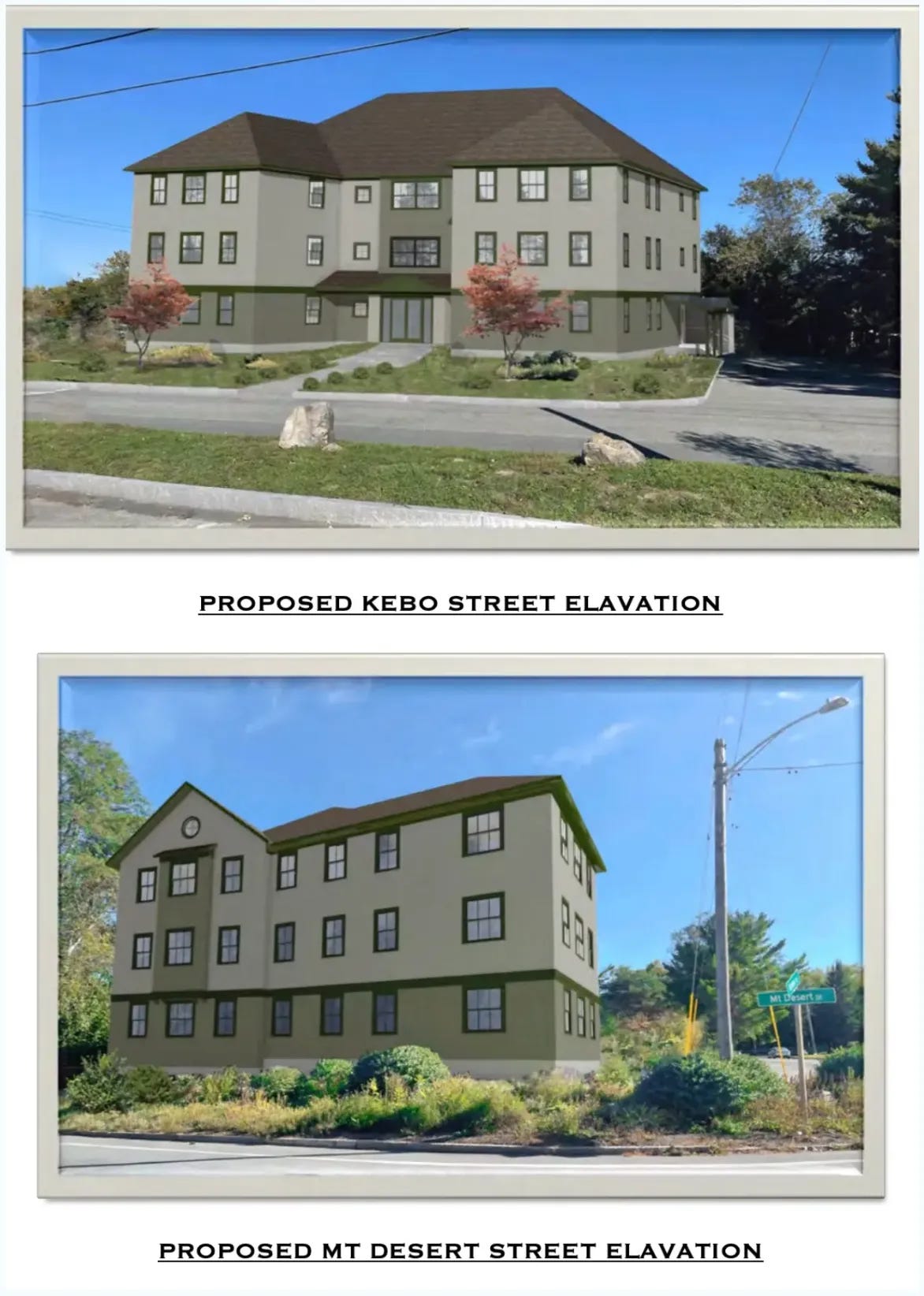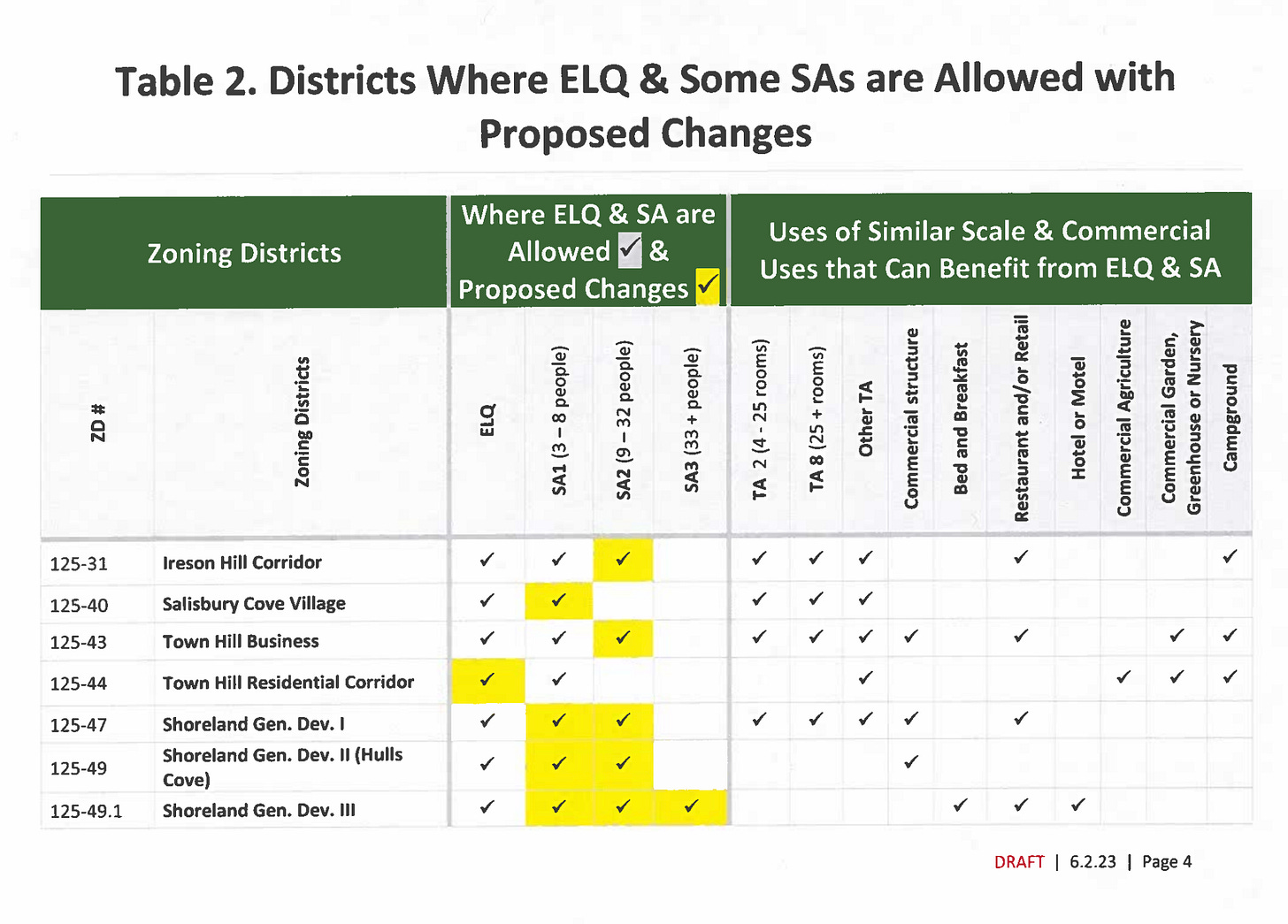Affordable housing on a farm?: Bar Harbor may change the rules so there can be more options
Bonus Good News: Witham Family Hotels Charitable Fund Pledges Matching Gift up to $20,000 for Food Pantry
BAR HARBOR—At least one farm in Bar Harbor would like the town’s land use ordinance changed to make it easier to supply housing for their employees. Since that February request, Bar Harbor Staff Planner Cali Martinez has been collating information and working on a proposal to allow employee living quarters in zones where farms are allowed in Bar Harbor.
Back at a February 3 Planning Board meeting, Glenon Friedmann, representing Bar Harbor Farm at 115 Gilbert Farm Road in the Town Hill rural district, said that one of the farm’s biggest challenges is employee housing. The farm originally had a plan that had a few cabins for workers, but it couldn’t build the cabins and get a permit because it wasn’t an allowed use in that district. Friedmann asked that farm employee housing be added as an allowed use in the zone. She is married to Town Councilor Gary Friedmann who was not present during the request. It is so far the only farm that has made the request.
SINCE THEN . . .
The Bar Harbor Planning Board and planning department staff began in 2019 to try to help meet the need for housing options for workers that would be more versatile than what is currently allowed in town. Employee living quarters (ELQ) and three categories of shared accommodations (SA) were created. Shared accommodations are not restricted to employees.
In 2020, the town passed shared accommodations creation as a use by a vote of 942-927. One shared accommodation and one employee living quarters are now under construction and two shared accommodation dwellings have already been built.
Shared accommodations do not have to be workforce housing nor do they have to be located on the same site as its owner. Employee living quarters (ELQ), however, do need to be on a commercial property as an accessory structure. Occupants need to be employed by the owner.
At a July 5 Planning Board meeting, Martinez said that the discussion is because one of the stake holders inquired about allowing employee living quarters in districts that allow commercial agriculture, campground, commercial gardens, or greenhouses requested it.
Shared accommodations can currently exist in eight zoning districts. Employee living quarters can exist in 14. The town has 40 zoning districts.
The draft proposal would allow SAs in six more districts and ELQs in an additional eight.
Martinez is still revising the proposal, now with additional Planning Board feedback, and will bring in another draft, most likely at the board’s August meeting.
“The Emery district includes portions of Wild Iris Farm, Peggy Rockefeller Farm, and Smith Family Farm. The Salisbury Cove Rural district includes Sweet Pea Farm. The Hulls Cove Rural district includes portions of Wild Iris Farm. The Town Hill Rural district includes Bar Harbor Farm,” Martinez wrote in her proposal.
HOW MANY PARKING SPACES ARE NEEDED AND HOW BIG CAN BUILDINGS BE?
Questions rose about how many parking spaces would be required if the changes pass. Similarly, questions arose about building size.
Often, the land use ordinance has parking requirements in different zones for different uses. The ordinance also has rules about building sizes. Currently, the existing ELQs can’t be larger than 25 percent of the primary use building that the employees work at. For a place like a farm, where there might not even be a barn, that becomes extremely restrictive for creating the size of a building. Sometimes there might not be a primary structure on site.
Planning Board Secretary Elissa Chesler asked, “How do you define the primary structure of a cornfield?”
“Campgrounds are a great example: what would be the principal structure?” Code Enforcement Officer Angie Chamberlain mentioned. “If someone has a 20 by 20 office, they can only have employee housing that is 25 percent of that.”
In order to create more incentives to construct more ELQs there was discussion about whether to remove the 25% stipulation for all ELQs. Other options would be to keep that stipulation in the downtown or keep it everywhere.
Board member Joseph Cough asked if the town was trying to incentivize these uses or just allow them because the owners want them.
Currently ELQs don’t require parking because they are only located near commercial centers that are walkable and bikable. The board discussed whether there should be flexibility in the requirement. Cough worried that flexibility could lead to loopholes, which was a term Planning Board Chair Millard Dority disagreed with. Dority said the Town of Mount Desert does not have parking standards written into its ordinance and that it’s done on a case-by-case basis. Cough worried about the perception of favoritism if Bar Harbor were to proceed that way.
Chamberlain said that most applicants want to know what the standards are when they come in.
Martinez said she’d continue to investigate the issue of parking spaces and how to determine how many are needed.
“It has to be a town-wide solution that everyone in town can support,” Planning Board Vice Chair Ruth Eveland said about whatever the Planning Board decides when Martinez presents a final plan.
THE BIGGER ISSUES
Finding affordable housing for residents and workers and helping to support the creation of that housing is an issue not just for workers in Bar Harbor, but across the country where housing supply options are slim, a shift to remote work has helped increase the demand for space, millennials are looking to buy, and there’s a lack of supply.
This also relates to rental units.
A recent article in NPR writes,
“The vast majority of low-income renters must rely on market-rate housing, but the U.S. hasn't built enough housing for more than a decade, since the market crash of 2008.
“And the shortage is most acute for the lowest income renters — by more than 7 million units, according to the National Low Income Housing Coalition.
“That tight market, combined with the worst inflation in a generation last year, has led to double-digit rent spikes in many places around the U.S.”
Similarly, rents in Bar Harbor and throughout the country are just not possible for many. According to that same NPR article, the median household rent payment for many people right before they are homeless is $960. Back in 2018, a housing survey by the Island Housing Trust stated that the median monthly rent in Bar Harbor was $892.
According to updated U.S. census data, the median gross rent from 2017-2021 is $924. The median household income for that same time period in 2021 dollars is $71,900, and the per capital income is $40,636. An estimated 10.1% of residents are in poverty.
Farmers are not the only occupations or employers dealing with trying to find workers and then also trying to find housing for those workers.
In a story last week, we mentioned the Friends Of Acadia’s 2023 impact statement, “Addressing the Seasonal Workforce Housing Challenge,” which reads,
“In 2022, Acadia National Park attempted to hire 165 seasonal positions and could only fill 116, including only about half of the needed trail crew. This was in large part due to lack of affordable housing, which has now become a crisis on Mount Desert Island.
“Friends of Acadia is working with the National Park Service and other partners to provide affordable seasonal workforce housing by developing a seasonal workforce housing strategy with a goal to provide the 130 new beds needed for the park and partners.
“This will help advance our strategic priorities and ensure that the park is able to protect park resources and provide for visitor enjoyment. It also helps makes jobs in Acadia accessible to all. Most graduates today leave college with an immense amount of debt and can’t afford expensive housing costs as they enter the workforce. Providing safe, affordable seasonal housing will reduce this barrier.
The town’s housing survey conducted in November of 2022 showed that of those surveyed, a majority of the employers (84 percent) said that their employees not living in Bar Harbor have difficulty finding housing that meets their needs. Of the employers responding, 76 percent said they lost an employee due to lack of housing or housing affordability in town. The survey also asked what employers believed were the barriers to housing.
Of the 424 people who responded who live and work in Bar Harbor only 7 percent didn’t have permanent housing. About one-third lived in their current residence for less than a year
Of those who don’t find their housing meets their needs, more than half said that it was too expensive. Of the respondents to that section of the survey, 39 percent paid less than $1,000 for monthly housing including rent/mortgage, utilities, insurance, and taxes. More than 56 percent paid less than $1,500. A quarter of the respondents who live and work in Bar Harbor were under 25. The majority of respondents (in that same demographic for the survey area—68 percent) were between 25 and 64.
For an earlier story about Martinez’ proposal and more thorough discussion on housing issues click here or go to our main site and search “housing” and see a plethora of stories.
BAR HARBOR FOOD PANTRY GETS MATCHING GIFT
After our story ran about the Bar Harbor Food Pantry’s Christmas in July event, the Witham Family Hotels Charitable Fund and Bar Harbor Food Pantry announced that the fund will match up to $20,000 of donations to the Christmas in July event.
“The Witham Family Hotels Charitable Fund and ongoing partnership with the Bar Harbor Food Pantry aligns strongly with our mission statement. Food insecurity is its highest need nationwide. We are thankful for all the hard work the Bar Harbor Food Pantry does for our community,” Christine Witham said.
The pantry’s director Tom Reeve said it was a great way to double the impact of your gift.
On July 19, from 10 a.m. to 6 p.m., the Bar Harbor Food Pantry, in partnership with the Criterion Theatre and Side Street Cafe, will host Christmas in July, a campaign to fill every seat of the historic theater with donations. They don’t want to fill the seat with theater patrons. They want to fill the seats with bags of food (or money) for the Bar Harbor Food Pantry.
“We hope to sell all 760 seats, raising $20,000 to help fill our budget gap,” Reeve said. Every $25 raised will fill one seat and cover the weekly cost for a two-person household to visit the pantry.
According to the organization’s press release, “This past May and June, the pantry served a record number of customers. As the pantry faces growing demand for services, donations are increasingly important. We are hoping our community will help us fill the gap by buying a seat and filling it with food or funds.”
Local businesses have made sponsorships to cover the costs associated with the event. With this support, every donation collected leading up to and on the date of the event will go directly to serving community members facing food insecurity.
HOW TO HELP
Financial donations can be made at BarHarborFoodPantry.com/xmas at any time leading up to the event.
Food can be donated at the pantry, Hannaford’s on Cottage Street, and the YWCA drop box in the lobby.
Food and funds will also be collected from 10 a.m. - 6 p.m. on July 19th at the Criterion Theatre in Bar Harbor. Questions and information about sponsorship opportunities can be sent to Tom Reeve at Bhpantry@BHFP.org.
To donate, go to barharborfoodpantry.org/xmas.
The food pantry is located behind the YWCA. It’s open on Tuesdays and Wednesdays from 9 a.m. to 2 p.m., Thursdays from noon to 6 p.m. and Fridays from 9 a.m. to noon. Donations can be made at https://www.barharborfoodpantry.org/xmas
LINKS TO LEARN MORE
https://www.townhallstreams.com/stream.php?location_id=37&id=49572
https://www.barharbormaine.gov/282/Planning-Board
https://www.barharbormaine.gov/AgendaCenter/Planning-Board-13/?#_07052023-3239
https://www.barharbormaine.gov/AgendaCenter/ViewFile/Agenda/_07052023-3239



















